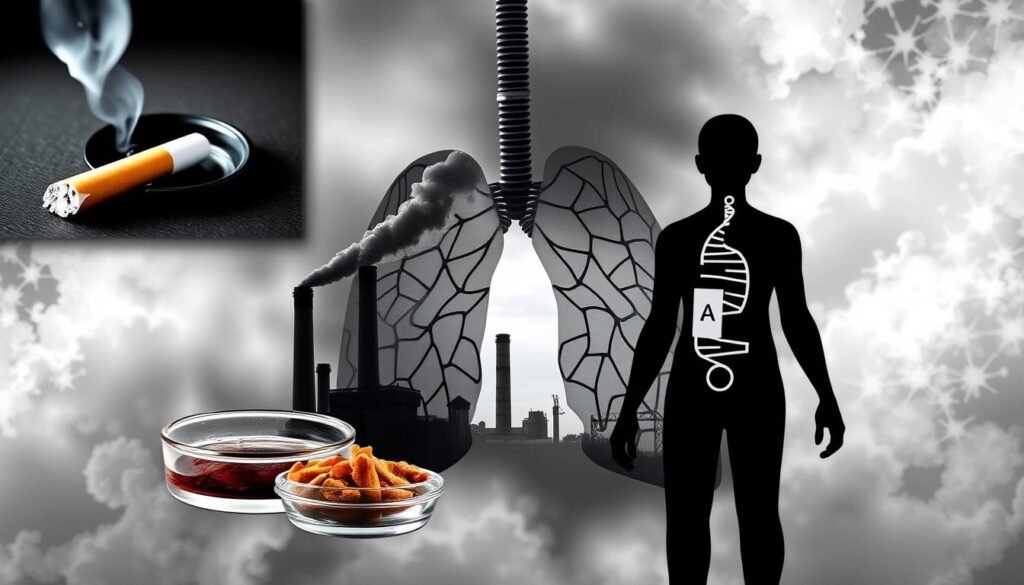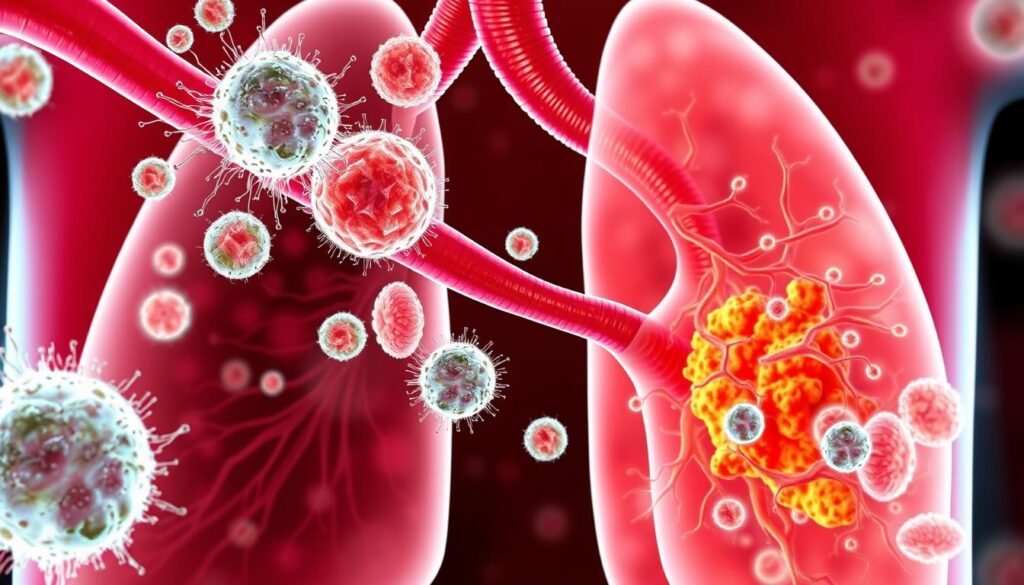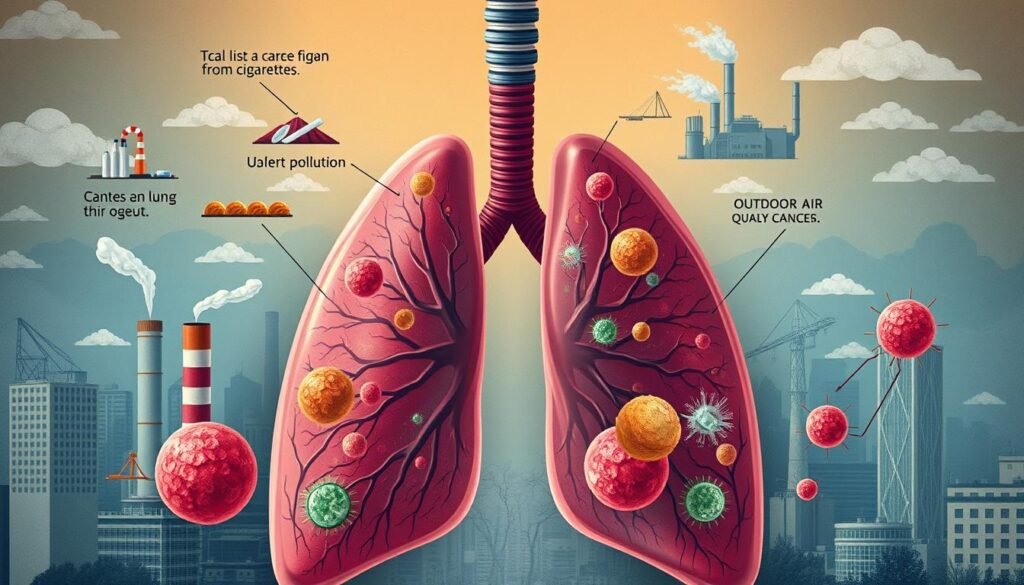Lung cancer is the top killer in the world of cancers. Small cell lung cancer (SCLC) is particularly tricky. It often stays hidden until it’s serious. People who have smoked a lot are at risk. This cancer grows quickly and can get very bad if we don’t catch it early.
So, knowing what to look out for is key. Signs like a non-stop cough, pain in the chest, and feeling winded are clues. If we pay attention to these signs, we can get help fast. This is super important for dealing with this dangerous cancer.
Key Takeaways
- Lung cancer, including small cell lung cancer, is the leading cause of cancer deaths globally.
- Recognizing common symptoms can lead to earlier diagnosis and treatment.
- Persistent cough, chest pain, and shortness of breath are key indicators of SCLC.
- Early detection significantly improves treatment effectiveness.
- Smokers are at a higher risk of developing small cell lung cancer.
- Understanding lung cancer signs is essential for personal health vigilance.
Understanding Small Cell Lung Cancer
Small cell lung cancer (SCLC) is a unique kind of lung cancer. It’s different from non-small cell lung cancer. Most often seen in heavy smokers, it makes up about 10%-15% of all lung cancer cases. It grows quickly, making it key to know the symptoms and how to treat it.
SCLC is mainly found in two stages: limited and extensive. In the limited stage, the cancer is only in one lung and maybe nearby lymph nodes. About one-third of people have this at diagnosis. The extensive stage means the cancer has spread more widely. This happens in about two-thirds of cases.
It’s vital to understand SCLC to catch symptoms early. Watch out for things like ongoing coughing, trouble breathing, and chest pain. These signs usually show up a few months before people get help. Chest x-rays and CT scans are what doctors use to find out if someone has SCLC and see how far it’s spread.
Treating SCLC depends on its stage. Choices include chemotherapy, radiation, surgery, and immunotherapy. Each treatment has side effects. For instance, radiation might cause skin issues and tiredness. Chemo can lead to feeling sick and losing hair. Knowing these effects is crucial for those dealing with SCLC.
Many people look into clinical trials for new treatments. When talking to doctors, ask about diagnosis, treatment plans, and side effect management. This helps patients make informed choices and feel in control.
What is Small Cell Lung Cancer?
Small cell lung cancer (SCLC) is a fast-moving type of lung cancer. It makes up about 15% of all lung cancer cases. There are two kinds of SCLC: pure small cell and combined small cell. This cancer grows quickly and often spreads to other parts of the body early on.
SCLC is more common in men than in women. Most people who get it have smoked cigarettes. It starts in the center of the chest, in the breathing tubes. There, it forms big tumors that can spread to places like the brain and liver.
Many who have SCLC face a tough road ahead. About 30% have limited-stage disease when they find out they have cancer. Most others have extensive-stage disease. People with limited-stage SCLC can live up to 30 months. But if the disease has spread, they might live 7 to 13 months. Many have symptoms like trouble breathing, being very tired, and chest pain.
It’s important to understand SCLC well, including how it’s classified in medical codes. Using the right codes helps patients get better treatment and can make billing smoother. For more info, check this detailed guide on SCLC coding.
Common Symptoms of Small Cell Lung Cancer
Knowing the signs of small cell lung cancer is key for quick diagnosis and treatment. People may face many distressing signs which can greatly hurt their life quality. Finding these signs early helps start early treatment, making outcomes better.
Persistent Cough
A persistent cough that usual remedies can’t fix is often an early sign. This lasting cough can get worse, suggesting there might be a deeper problem needing a check-up.
Chest Pain and Discomfort
Some people feel chest pain that comes in sharp or dull forms. This pain might get worse with coughing or deep breaths. It’s vital to pay attention to this pain as it might point to tumor growth or more lung cancer issues.
Shortness of Breath
Feeling shortness of breath happens often in those with small cell lung cancer. This problem gets worse as tumors grow or airways get blocked. Look for medical help if breathing gets tough.
Wheezing
Wheezing makes a whistling sound when you breathe and means airflow is blocked. This sign can show lung cancer is present and should not be ignored.
Hoarseness and Difficulty Swallowing
As the cancer grows, hoarseness and swallowing troubles can start. These can mess with day-to-day life and need quick care from doctors.
Differences Between Small Cell Lung Cancer and Non-Small Cell Lung Cancer
The differences small cell lung cancer and non-small cell lung cancer are key in lung cancer types. They show different patterns, treatments, and outcomes that affect patients. Let’s explore how these two kinds are different.
Small cell lung cancer (SCLC) is about 15% of lung cancer cases. It’s very aggressive and spreads quickly. On the other hand, non-small cell lung cancer (NSCLC) makes up about 85% of cases. It usually grows more slowly.
NSCLC includes adenocarcinoma, squamous cell carcinoma, and large-cell undifferentiated carcinoma. SCLC is mostly caused by smoking, affecting 98% of its cases. NSCLC also has risks like pollution and genetics.
SCLC has a tough survival rate, under 5% over five years. This shows it’s hard to manage once found. NSCLC, however, offers better odds. Its 5-year survival rates can be as high as 64% if caught early. But it drops to 8% if it has spread.
In conclusion, knowing the difference between small cell and non-small cell lung cancer is crucial. This knowledge aids in treatment and understanding lung health better.
| Characteristic | Small Cell Lung Cancer | Non-Small Cell Lung Cancer |
|---|---|---|
| Percentage of Cases | 15% | 85% |
| Growth Rate | Aggressive and rapid | Slower |
| Smoking Link | 98% linked to smoking | Also linked to smoking, but includes other risk factors |
| Survival Rate (5-Year) | Less than 5% | 64% (early stages) to 8% (advanced stages) |
| Common Treatment | Chemotherapy and radiation | Surgery, chemotherapy, and targeted therapy |
Lung Cancer Stages and Their Significance
Lung cancer staging is key in figuring out treatment options. It tells doctors how far the cancer has spread. This greatly affects prognosis and how the cancer is managed. For small cell lung cancer (SCLC), there are mainly two stages.
Stage Description
SCLC is split into limited stage, where cancer is just in one lung, and extensive stage, where it’s spread more. About one in three people have limited-stage when they’re diagnosed. About two-thirds have extensive disease at diagnosis. Staging shows us how advanced the cancer is, which helps decide on treatment.
Symptoms at Different Stages
Symptoms of SCLC differ by stage. In early stages, signs might be a cough or feeling a bit short of breath. As cancer grows, symptoms get worse. Those with extensive-stage SCLC may find it hard to breathe, lose weight, and feel very tired.
| Stage | Description | Common Symptoms |
|---|---|---|
| Limited Stage | Cancer confined to one lung | Mild cough, occasional shortness of breath |
| Extensive Stage | Cancer spread beyond one lung | Severe breathlessness, significant weight loss, fatigue |
Risk Factors for Small Cell Lung Cancer
Understanding small cell lung cancer’s risk factors is key. The main cause is smoking, responsible for about 80% of cases. Smokers significantly increase their chance of getting small cell lung cancer (SCLC).
Environmental factors are also important. Radon gas is the second leading cause of this cancer, especially in non-smokers. Asbestos exposure increases the risk too, especially with smokers. Other risks include being older, male, and exposed to pollution.

We also worry about e-cigarettes and marijuana smoke. The FDA says e-cigarettes are risky. They could affect lung cancer odds, but it’s not yet clear. Marijuana smoke has harmful tar and carcinogens, like cigarette smoke does.
Knowing these risks helps people prevent lung cancer. Quitting smoking is the best prevention. Support, medicine like varenicline, and counseling help people quit.
| Risk Factor | Explanation |
|---|---|
| Smoking | Accounts for about 80% of lung cancer deaths; over 95% of SCLC patients smoke. |
| Radon Exposure | Second-leading cause of lung cancer, particularly affecting non-smokers. |
| Asbestos | Increases risk, especially for individuals with a history of smoking. |
| Age and Gender | Advanced age and being male are significant risk factors. |
| Pollution | Outdoor air pollution is responsible for 1-2% of lung cancer deaths. |
| Marijuana and E-Cigarettes | Possibly increase risk due to carcinogens present in smoke. |
Recognizing these factors is vital for lung cancer prevention. By being aware and taking action, we can lower our risk of small cell lung cancer.
Lung Cancer Treatment Options
Lung cancer treatments depend on the disease stage and the patient’s situation. The goal is to achieve the best outcome while considering the patient’s health and preferences. Knowing the available treatments helps in making informed decisions.
Surgical Interventions
For small cell lung cancer, surgery is rare due to its spread speed. It might be an option in early stages but is not common. Surgery, along with other treatments, is considered for limited-stage disease.
Chemotherapy and Radiation Therapy
Chemotherapy is key, especially for small cell lung cancer, often combined with radiation. It aims to kill cancer cells and improve survival. Treatments include cisplatin and etoposide or carboplatin and etoposide. Thoracic radiation after chemotherapy can boost survival chances.
Targeted Therapies
Targeted therapies are becoming popular, aiming at cancer cells’ specific traits. Combined with traditional treatments like chemotherapy, they enhance effectiveness. Agents like Lurbinectedin offer hope against tough cases. Research continues for better treatments to improve lives.
| Treatment Method | Description | Usage |
|---|---|---|
| Surgery | Involves removal of tumor in early-stage cases. | Limited application in very early-stage SCLC. |
| Chemotherapy | Drug treatment targeting cancer cells. | Primary treatment for most SCLC patients. |
| Radiation Therapy | Uses high-energy rays to kill cancer cells. | Commonly used in combination with chemotherapy. |
| Targeted Therapy | Targets specific characteristics of cancer cells. | Emerging option for resistant cases. |
| Chemoradiation | Combines chemotherapy and radiation therapy. | Effective for limited-stage SCLC. |
Metastatic Lung Cancer: When Cancer Spreads
Metastatic lung cancer is when lung cancer spreads to other body parts. This spread, known as SCLC spread, happens through blood or lymph systems. It can affect the liver, brain, and bones. Knowing about this spread is key to handle the disease well.
Small cell lung cancer (SCLC) is very aggressive. People with metastatic small cell lung cancer have a low five-year survival rate of 3 percent once it spreads widely. If it spreads just regionally, their chances improve slightly, with a rate of 18 percent. For comparison, stage 4 non-small cell lung cancer (NSCLC) patients have an 8 percent survival rate when it spreads far and 37 percent if it’s regional.
Metastatic lung cancer symptoms vary by its location:
- Brain: Key signs include confusion, severe headaches, and limb weakness.
- Liver: Look out for abdominal pain, jaundice, and weight loss.
- Bones: Leg weakness and numbness can occur, along with loss of bladder or bowel control.
- Adrenal Glands: Faintness and fatigue are common symptoms.
- Lymph Nodes: Swollen neck and armpit lumps can indicate spread to lymph nodes.
Treating metastatic lung cancer involves various approaches according to patient needs. Common treatments include chemotherapy, targeted therapies, and immunotherapy. Both internal and external radiotherapy can help ease metastasis symptoms.

Regular check-ups are crucial for adjusting treatment and handling symptoms like coughing and breathlessness. Understanding their prognosis helps patients make important care decisions as they deal with metastatic lung cancer.
| Stage | Type | 5-Year Survival Rate |
|---|---|---|
| Metastatic SCLC | Widespread | 3% |
| Stage 4 SCLC | Regional | 18% |
| Stage 4 NSCLC | Distant | 8% |
| Stage 4 NSCLC | Regional | 37% |
Lung Cancer Survival Rates and Prognosis
Small cell lung cancer (SCLC) is known for its aggressiveness. About 10-15% of all lung cancers are SCLC. This type shows how hard treatment and improving outcomes can be. The 5-year survival rate for SCLC is only about 7%.
In comparison, non-small cell lung cancer (NSCLC) has better survival rates. Localized NSCLC has a 65% 5-year survival rate, while localized SCLC’s rate is much lower at 30%. For advanced stages, SCLC’s survival drops to 3%, vs. NSCLC’s 9%.
Knowing the stage of SCLC at diagnosis is key. Around 33% of patients are diagnosed at a limited stage. The rest face extensive-stage cancer. Early detection helps, with a 27% survival rate for localized stages. But later-stage patients have a grim 3% rate.
| Stage | SCLC 5-Year Survival Rate | NSCLC 5-Year Survival Rate |
|---|---|---|
| Localized | 30% | 65% |
| Regional | 18% | 37% |
| Distant | 3% | 9% |
| All Stages Combined | 7% | 28% |
These survival rates show why research, education, and early detection are critical. Although SCLC’s outlook is often bleak, fighting lung cancer with these tools can pave the way for better futures.
Lung Cancer Causes and Prevention Strategies
Lung cancer is a major health issue worldwide. It’s the top cause of cancer deaths. Knowing what causes lung cancer is key to prevent it. About 85% of lung cancer cases are due to smoking. Cutting down or stopping smoking can greatly reduce your risk.
Smoking as a Primary Risk Factor
Every cigarette smoked is harmful. Even light smoking raises your risk of lung cancer. But quitting smoking can reduce your risk. A shocking 87% of lung cancer deaths in men and 70% in women are caused by smoking. This highlights the need for public health efforts to curb smoking. Programs that help people stop smoking are critical in fighting lung cancer.
Reducing Exposure to Carcinogens
It’s also important to reduce exposure to carcinogens. This means staying away from toxic environments and following safety rules at work. Homes should be checked for radon gas, which can cause lung cancer. These steps, along with educating the public, are key in preventing lung cancer. For more information, check out lung cancer prevention resources.

Lung Cancer Screening: Importance and Methods
Lung cancer is the top cause of cancer deaths in the U.S. Detecting it early is key to better treatment results. Screenings are very important, especially for those who smoke a lot or used to. One way to screen is by using low-dose computed tomography (LDCT) scans. These scans are good at finding lung cancer early, which helps treatment work better.
The American Cancer Society suggests LDCT scans every year for 50 to 80-year-olds who smoked a lot. Studies show these scans help reduce lung cancer deaths in heavy smokers. This was clear in a study that looked at people 55 to 74 years old who smoked for 30 years or more. This study found LDCT scans better at spotting early lung cancer compared to chest x-rays.
Early detection of lung cancer, like SCLC, is critical. But, LDCT scans might not catch every lung cancer. Sometimes, findings lead to more tests, like lung biopsies. Even though LDCT scans use some radiation, the risk is worth it for heavy smokers.
It is important for people to talk to their doctors about lung cancer screening. If you have lung cancer in your family, have COPD, or had lung cancer, think about getting screened. Knowing about these screenings can improve health and even save lives.
| Screening Method | Effectiveness | Recommendation |
|---|---|---|
| LDCT Scans | Increased detection of early-stage lung cancer | Yearly for ages 50-80 with smoking history |
| Chest X-Rays | No significant benefit in survival | Not recommended |
| Further Testing | Required for abnormal results | Depends on findings from LDCT |
Screening is a lifeline for those at risk. It leads to early treatment and better health.
Conclusion
Small cell lung cancer’s symptoms often look like those of other breathing issues. This makes careful checks by doctors very important. Knowing the signs, like a constant cough and feeling short of breath, is crucial. This is especially true for folks who smoke and older adults. Quick action and being aware can really help with treatment.
It’s super important to catch it early. Getting regular checks can help find it sooner. This can make treating it easier and may help people live longer. There’s a lot of helpful info out there, including on Medical News Today and Care Your Lungs.
Knowing more about this tough kind of lung cancer can help people take steps to prevent it. It’s important to see a doctor early and speak up about your health. This hands-on way can make a big difference in fighting small cell lung cancer. It leads to better chances of beating the disease.